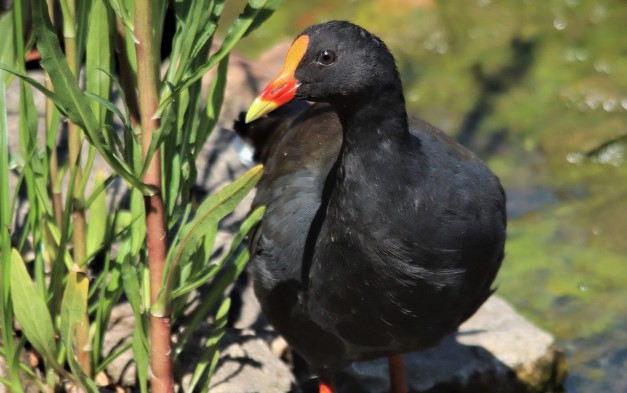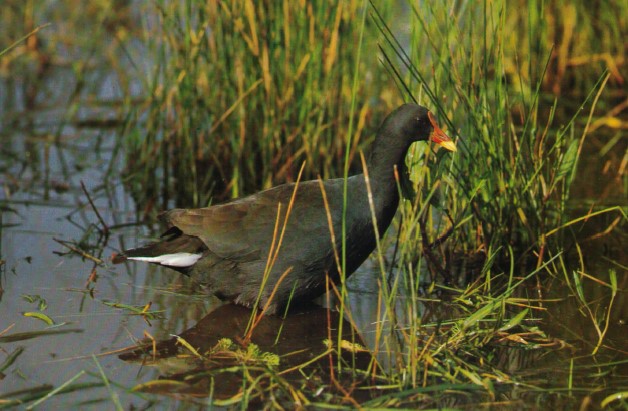The Dusky Moorhen, “Gallinula tenebrosa” is a larger size.
Its darker color and red legs make it a prominent Australasia and Eurasian moorhen. Dusky Moorhens are about 340–380 mm long. It feeds in freshwater by swimming and on land by walking. It lives in swamps, lakes, and waterways in which reed-margined waters abut grassy banks for grazing. It eats aquatic plant matter, insects, fish, molluscs, and worms. This is also known as black gallinule and black moorhen. The Dusky Moorhen territorial raucous crowing call; soft mewing call before sexual behavior; raucous squawks if alarmed; miscellaneous staccato calls; contact clicks by adults to chicks; short descending whistles or shrill piping calls by chicks.
On land, Dusky Moorhens will use their feet to anchor food. However, in water, they will upend to find it. They drink and bathe regularly, often preening one another. At night, they retire to grouped roosting platforms up to two meters above water in reeds and shrubs, each bird selecting its own and standing to sleep. The birds also use the platforms for resting during the day and even mating. Dusky Moorhens are sedentary and territorial, and form groups of two to seven birds, comprising one to three males and a female.

During breeding, the group defends its territory through threat display, calling, and even fighting in border disputes. Females initiate courtship and mate with all males in their group. The entire group builds the nest, pulling down nearby stalks and pressing them into shape by turning the body. Eggs are laid daily until the clutch is complete, and then the group takes turns in incubation. Newly hatched young are taken to a second, deeper-water nursing nest and brooded there for about three days. After that, they are led on foraging forays by one adult at a time. For the first four weeks, they are fed intensively and taken back to the nursery to sleep, brooded, at night. Parental feeding ceases at nine weeks.
Both sexes are similar. General plumage is sooty-washed brown on the back. White lines on each side of the tail show clearly when the tail flickers up and down. Occasional white flecks on the flanks and a red frontal shield on the forehead. Their eyes are brown. The bill is red with a yellow tip. Feet are green, with reddish knees, all reddish when breeding. The immature bird is much duller than adults, with a whitewash on the breast and belly, a yellow-green bill and frontal shield, and green feet. Downy Young is black, with no white under the tail. Bill is red. Bare orange-yellow patches on the skin and the leading edge of the wings.

Nesting and breeding occur in August–February, often with two broods per season. A nest is a substantial, slightly dished platform of aquatic vegetation, usually among rushes or at the base of a tree growing in a swamp. Dusky Moorhen lays 5 to 8 eggs per female in a group; off-white, with red-brown and grey blotches and spots; oblong-oval, about 53 x 36 mm. The incubation period is about 20–24 days, according to the group.
Dusky moorhen is found in freshwater swamps and parkland lakes in eastern Australia, north of the Cape York Peninsula. It is also found in far southwestern Australia, in particular in northeastern Tasmania. Vagrants reach Arnhem Land. Also in New Guinea and the Indonesian region. There are three races: one large with a narrow frontal shield in Australia.
Read More: American coot







